Research Methodology: Online Advertising's Effect on Customer Behavior
VerifiedAdded on 2023/04/21
|9
|2103
|174
Report
AI Summary
This report details the research methodology employed to investigate the impact of online advertising on customer behavior within China. It begins with an introduction outlining the significance of methodology in research, followed by an exploration of the research philosophy, specifically interpretivism, and the inductive research approach. The report then delves into research choices, favoring a qualitative approach, and explains the data collection methods, including primary and secondary sources, with a focus on survey methods. The sampling method, involving a random selection of 15 managers in China, is discussed, along with considerations for validity, reliability, and ethical issues such as confidentiality and restricted access. The data analysis techniques, limitations, and a detailed time frame using a Gantt chart and network diagram are also provided. The report concludes with a comprehensive list of references, providing a thorough overview of the research process and its various components.
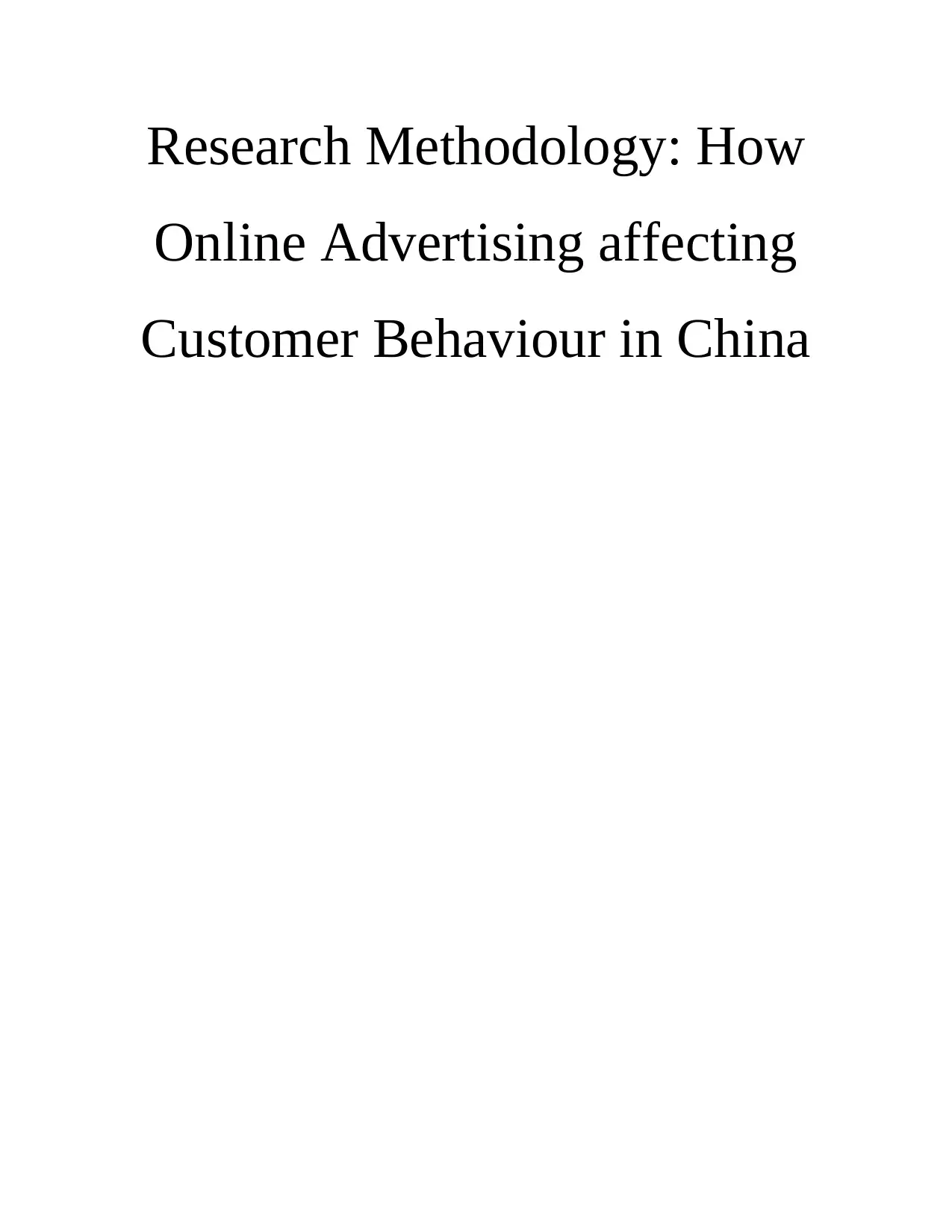
Research Methodology: How
Online Advertising affecting
Customer Behaviour in China
Online Advertising affecting
Customer Behaviour in China
Paraphrase This Document
Need a fresh take? Get an instant paraphrase of this document with our AI Paraphraser
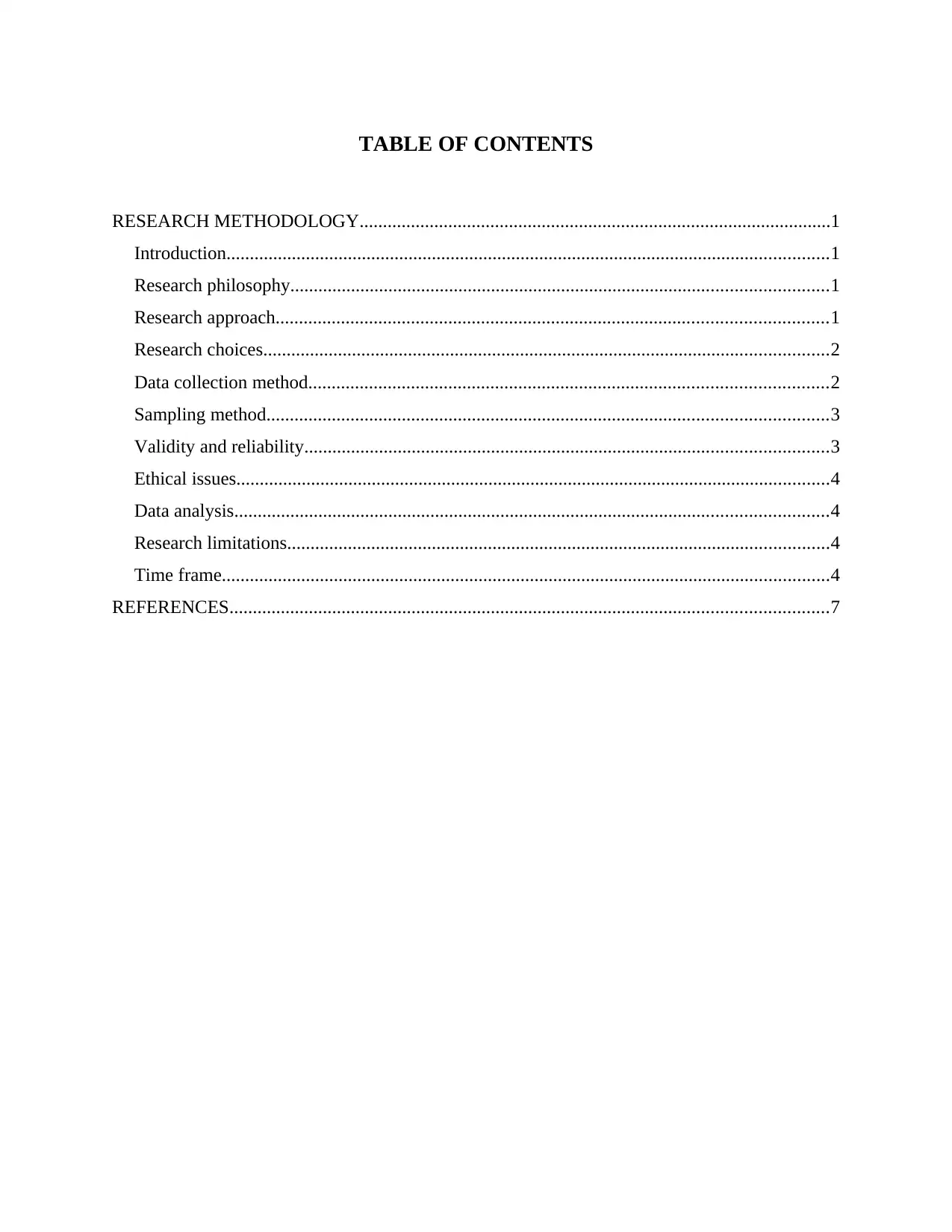
TABLE OF CONTENTS
RESEARCH METHODOLOGY.....................................................................................................1
Introduction.................................................................................................................................1
Research philosophy...................................................................................................................1
Research approach......................................................................................................................1
Research choices.........................................................................................................................2
Data collection method...............................................................................................................2
Sampling method........................................................................................................................3
Validity and reliability................................................................................................................3
Ethical issues...............................................................................................................................4
Data analysis...............................................................................................................................4
Research limitations....................................................................................................................4
Time frame..................................................................................................................................4
REFERENCES................................................................................................................................7
RESEARCH METHODOLOGY.....................................................................................................1
Introduction.................................................................................................................................1
Research philosophy...................................................................................................................1
Research approach......................................................................................................................1
Research choices.........................................................................................................................2
Data collection method...............................................................................................................2
Sampling method........................................................................................................................3
Validity and reliability................................................................................................................3
Ethical issues...............................................................................................................................4
Data analysis...............................................................................................................................4
Research limitations....................................................................................................................4
Time frame..................................................................................................................................4
REFERENCES................................................................................................................................7
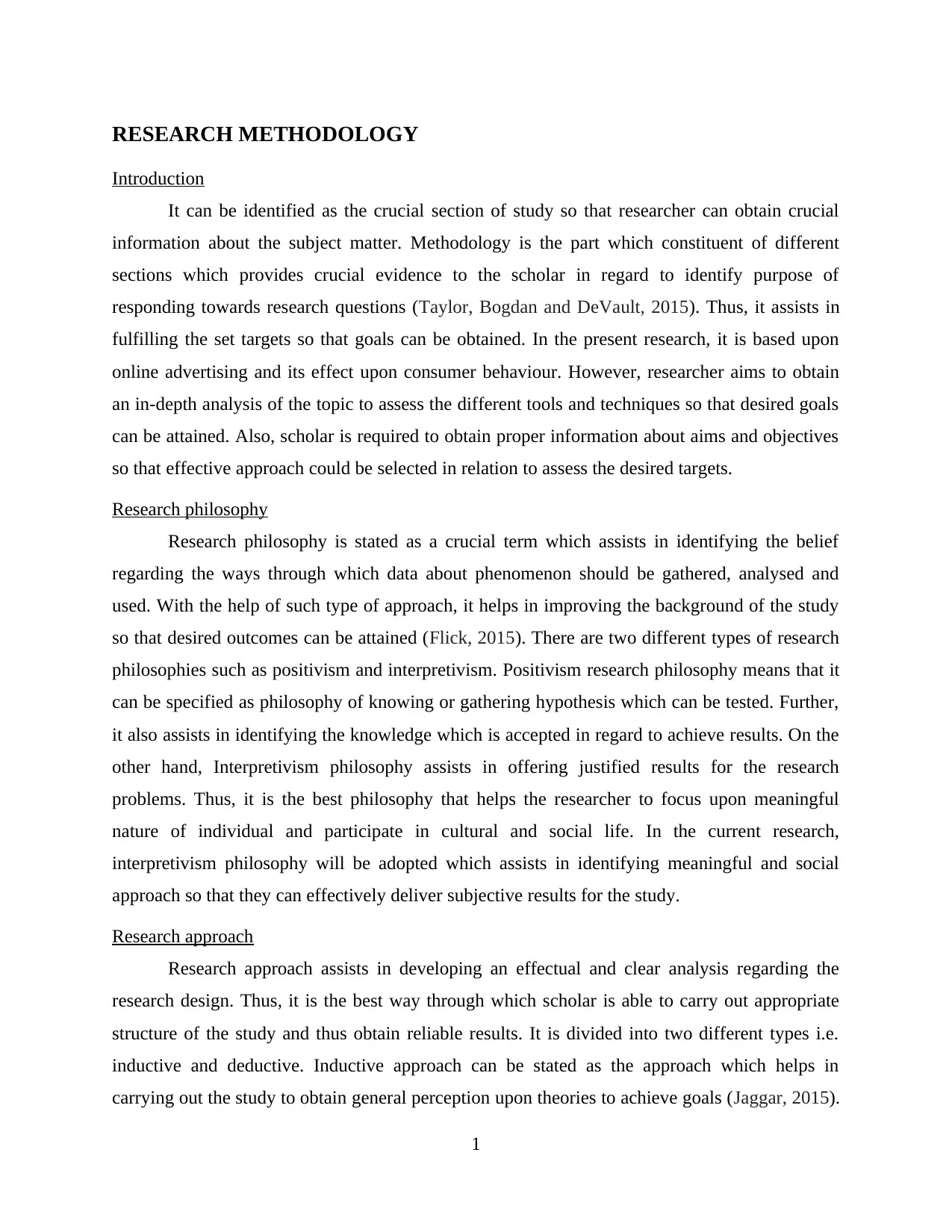
RESEARCH METHODOLOGY
Introduction
It can be identified as the crucial section of study so that researcher can obtain crucial
information about the subject matter. Methodology is the part which constituent of different
sections which provides crucial evidence to the scholar in regard to identify purpose of
responding towards research questions (Taylor, Bogdan and DeVault, 2015). Thus, it assists in
fulfilling the set targets so that goals can be obtained. In the present research, it is based upon
online advertising and its effect upon consumer behaviour. However, researcher aims to obtain
an in-depth analysis of the topic to assess the different tools and techniques so that desired goals
can be attained. Also, scholar is required to obtain proper information about aims and objectives
so that effective approach could be selected in relation to assess the desired targets.
Research philosophy
Research philosophy is stated as a crucial term which assists in identifying the belief
regarding the ways through which data about phenomenon should be gathered, analysed and
used. With the help of such type of approach, it helps in improving the background of the study
so that desired outcomes can be attained (Flick, 2015). There are two different types of research
philosophies such as positivism and interpretivism. Positivism research philosophy means that it
can be specified as philosophy of knowing or gathering hypothesis which can be tested. Further,
it also assists in identifying the knowledge which is accepted in regard to achieve results. On the
other hand, Interpretivism philosophy assists in offering justified results for the research
problems. Thus, it is the best philosophy that helps the researcher to focus upon meaningful
nature of individual and participate in cultural and social life. In the current research,
interpretivism philosophy will be adopted which assists in identifying meaningful and social
approach so that they can effectively deliver subjective results for the study.
Research approach
Research approach assists in developing an effectual and clear analysis regarding the
research design. Thus, it is the best way through which scholar is able to carry out appropriate
structure of the study and thus obtain reliable results. It is divided into two different types i.e.
inductive and deductive. Inductive approach can be stated as the approach which helps in
carrying out the study to obtain general perception upon theories to achieve goals (Jaggar, 2015).
1
Introduction
It can be identified as the crucial section of study so that researcher can obtain crucial
information about the subject matter. Methodology is the part which constituent of different
sections which provides crucial evidence to the scholar in regard to identify purpose of
responding towards research questions (Taylor, Bogdan and DeVault, 2015). Thus, it assists in
fulfilling the set targets so that goals can be obtained. In the present research, it is based upon
online advertising and its effect upon consumer behaviour. However, researcher aims to obtain
an in-depth analysis of the topic to assess the different tools and techniques so that desired goals
can be attained. Also, scholar is required to obtain proper information about aims and objectives
so that effective approach could be selected in relation to assess the desired targets.
Research philosophy
Research philosophy is stated as a crucial term which assists in identifying the belief
regarding the ways through which data about phenomenon should be gathered, analysed and
used. With the help of such type of approach, it helps in improving the background of the study
so that desired outcomes can be attained (Flick, 2015). There are two different types of research
philosophies such as positivism and interpretivism. Positivism research philosophy means that it
can be specified as philosophy of knowing or gathering hypothesis which can be tested. Further,
it also assists in identifying the knowledge which is accepted in regard to achieve results. On the
other hand, Interpretivism philosophy assists in offering justified results for the research
problems. Thus, it is the best philosophy that helps the researcher to focus upon meaningful
nature of individual and participate in cultural and social life. In the current research,
interpretivism philosophy will be adopted which assists in identifying meaningful and social
approach so that they can effectively deliver subjective results for the study.
Research approach
Research approach assists in developing an effectual and clear analysis regarding the
research design. Thus, it is the best way through which scholar is able to carry out appropriate
structure of the study and thus obtain reliable results. It is divided into two different types i.e.
inductive and deductive. Inductive approach can be stated as the approach which helps in
carrying out the study to obtain general perception upon theories to achieve goals (Jaggar, 2015).
1
⊘ This is a preview!⊘
Do you want full access?
Subscribe today to unlock all pages.

Trusted by 1+ million students worldwide
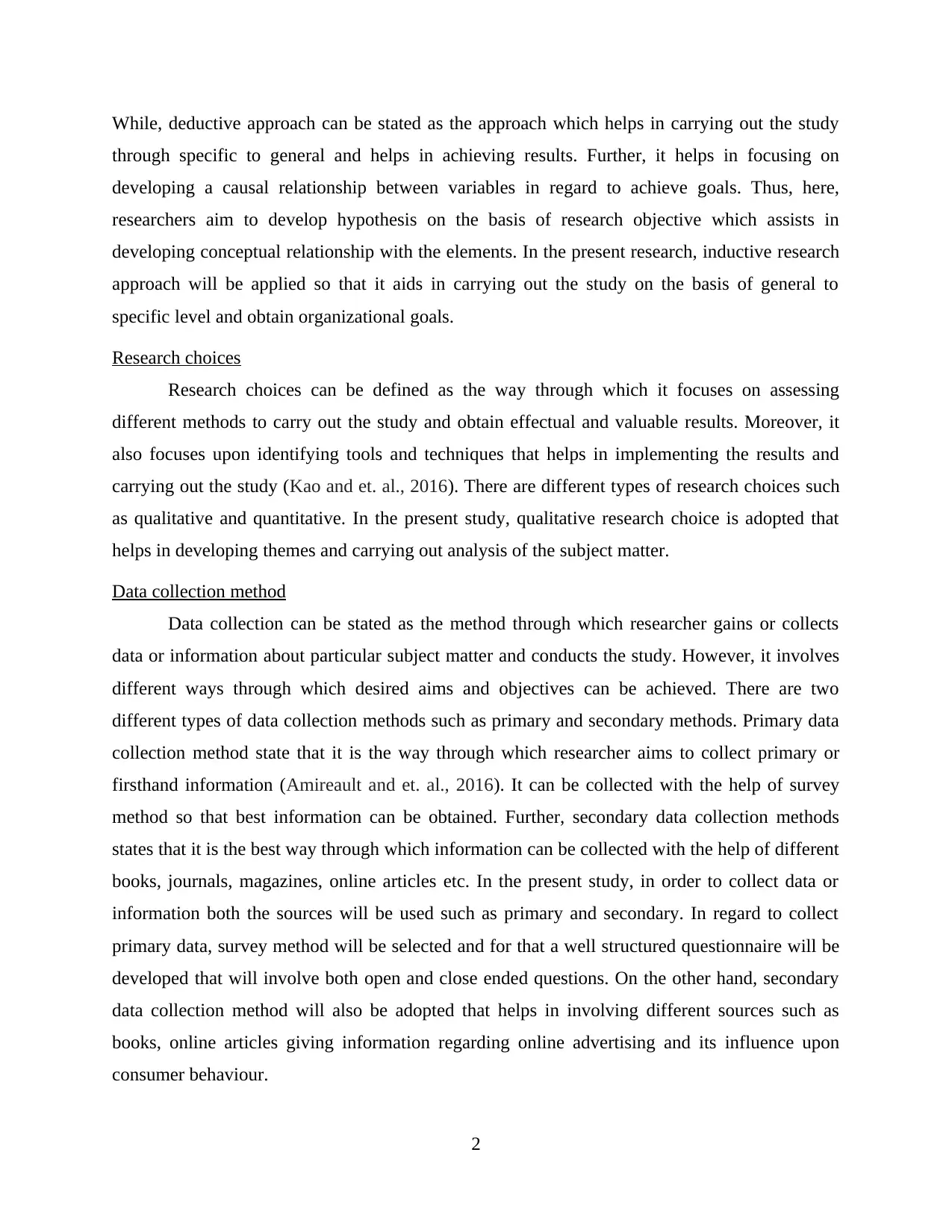
While, deductive approach can be stated as the approach which helps in carrying out the study
through specific to general and helps in achieving results. Further, it helps in focusing on
developing a causal relationship between variables in regard to achieve goals. Thus, here,
researchers aim to develop hypothesis on the basis of research objective which assists in
developing conceptual relationship with the elements. In the present research, inductive research
approach will be applied so that it aids in carrying out the study on the basis of general to
specific level and obtain organizational goals.
Research choices
Research choices can be defined as the way through which it focuses on assessing
different methods to carry out the study and obtain effectual and valuable results. Moreover, it
also focuses upon identifying tools and techniques that helps in implementing the results and
carrying out the study (Kao and et. al., 2016). There are different types of research choices such
as qualitative and quantitative. In the present study, qualitative research choice is adopted that
helps in developing themes and carrying out analysis of the subject matter.
Data collection method
Data collection can be stated as the method through which researcher gains or collects
data or information about particular subject matter and conducts the study. However, it involves
different ways through which desired aims and objectives can be achieved. There are two
different types of data collection methods such as primary and secondary methods. Primary data
collection method state that it is the way through which researcher aims to collect primary or
firsthand information (Amireault and et. al., 2016). It can be collected with the help of survey
method so that best information can be obtained. Further, secondary data collection methods
states that it is the best way through which information can be collected with the help of different
books, journals, magazines, online articles etc. In the present study, in order to collect data or
information both the sources will be used such as primary and secondary. In regard to collect
primary data, survey method will be selected and for that a well structured questionnaire will be
developed that will involve both open and close ended questions. On the other hand, secondary
data collection method will also be adopted that helps in involving different sources such as
books, online articles giving information regarding online advertising and its influence upon
consumer behaviour.
2
through specific to general and helps in achieving results. Further, it helps in focusing on
developing a causal relationship between variables in regard to achieve goals. Thus, here,
researchers aim to develop hypothesis on the basis of research objective which assists in
developing conceptual relationship with the elements. In the present research, inductive research
approach will be applied so that it aids in carrying out the study on the basis of general to
specific level and obtain organizational goals.
Research choices
Research choices can be defined as the way through which it focuses on assessing
different methods to carry out the study and obtain effectual and valuable results. Moreover, it
also focuses upon identifying tools and techniques that helps in implementing the results and
carrying out the study (Kao and et. al., 2016). There are different types of research choices such
as qualitative and quantitative. In the present study, qualitative research choice is adopted that
helps in developing themes and carrying out analysis of the subject matter.
Data collection method
Data collection can be stated as the method through which researcher gains or collects
data or information about particular subject matter and conducts the study. However, it involves
different ways through which desired aims and objectives can be achieved. There are two
different types of data collection methods such as primary and secondary methods. Primary data
collection method state that it is the way through which researcher aims to collect primary or
firsthand information (Amireault and et. al., 2016). It can be collected with the help of survey
method so that best information can be obtained. Further, secondary data collection methods
states that it is the best way through which information can be collected with the help of different
books, journals, magazines, online articles etc. In the present study, in order to collect data or
information both the sources will be used such as primary and secondary. In regard to collect
primary data, survey method will be selected and for that a well structured questionnaire will be
developed that will involve both open and close ended questions. On the other hand, secondary
data collection method will also be adopted that helps in involving different sources such as
books, online articles giving information regarding online advertising and its influence upon
consumer behaviour.
2
Paraphrase This Document
Need a fresh take? Get an instant paraphrase of this document with our AI Paraphraser
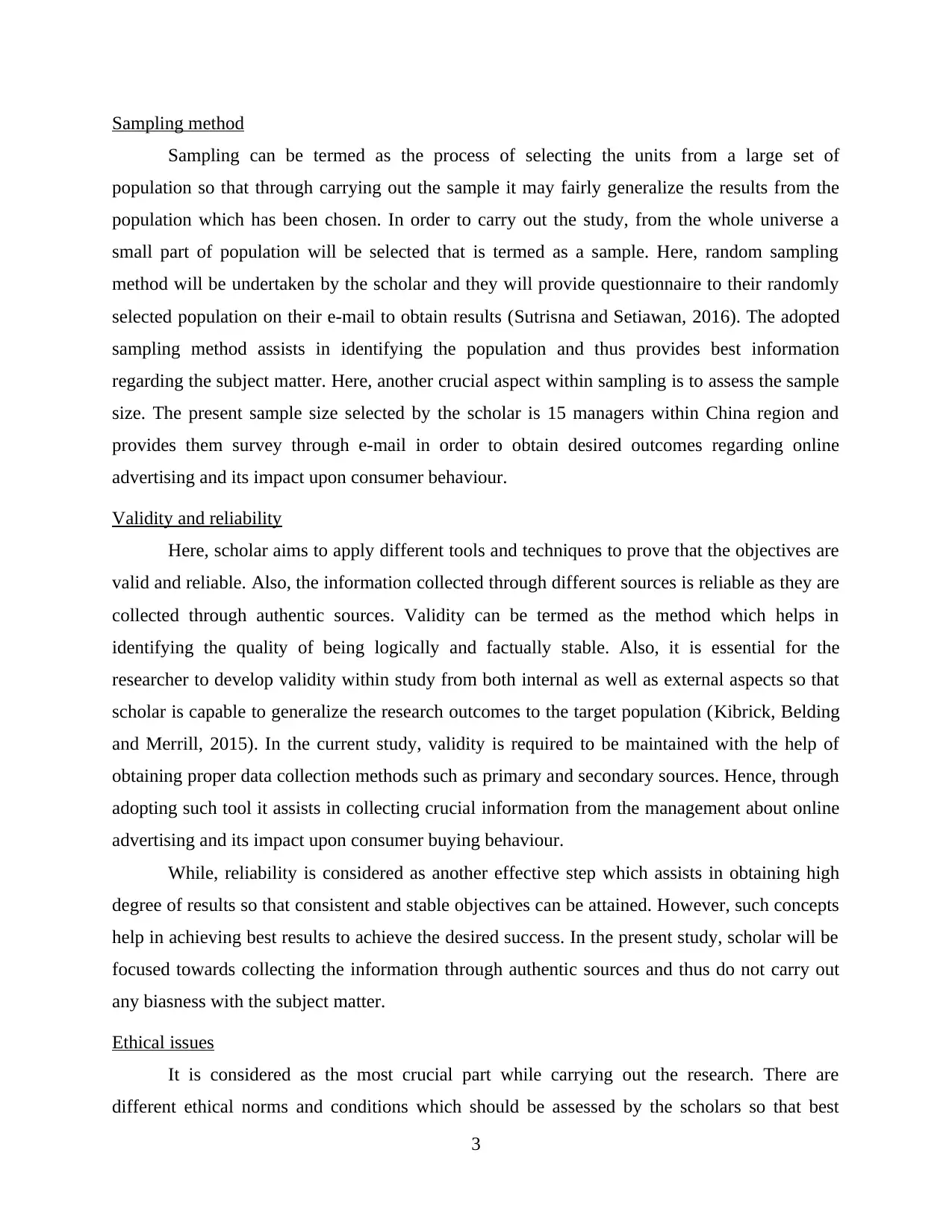
Sampling method
Sampling can be termed as the process of selecting the units from a large set of
population so that through carrying out the sample it may fairly generalize the results from the
population which has been chosen. In order to carry out the study, from the whole universe a
small part of population will be selected that is termed as a sample. Here, random sampling
method will be undertaken by the scholar and they will provide questionnaire to their randomly
selected population on their e-mail to obtain results (Sutrisna and Setiawan, 2016). The adopted
sampling method assists in identifying the population and thus provides best information
regarding the subject matter. Here, another crucial aspect within sampling is to assess the sample
size. The present sample size selected by the scholar is 15 managers within China region and
provides them survey through e-mail in order to obtain desired outcomes regarding online
advertising and its impact upon consumer behaviour.
Validity and reliability
Here, scholar aims to apply different tools and techniques to prove that the objectives are
valid and reliable. Also, the information collected through different sources is reliable as they are
collected through authentic sources. Validity can be termed as the method which helps in
identifying the quality of being logically and factually stable. Also, it is essential for the
researcher to develop validity within study from both internal as well as external aspects so that
scholar is capable to generalize the research outcomes to the target population (Kibrick, Belding
and Merrill, 2015). In the current study, validity is required to be maintained with the help of
obtaining proper data collection methods such as primary and secondary sources. Hence, through
adopting such tool it assists in collecting crucial information from the management about online
advertising and its impact upon consumer buying behaviour.
While, reliability is considered as another effective step which assists in obtaining high
degree of results so that consistent and stable objectives can be attained. However, such concepts
help in achieving best results to achieve the desired success. In the present study, scholar will be
focused towards collecting the information through authentic sources and thus do not carry out
any biasness with the subject matter.
Ethical issues
It is considered as the most crucial part while carrying out the research. There are
different ethical norms and conditions which should be assessed by the scholars so that best
3
Sampling can be termed as the process of selecting the units from a large set of
population so that through carrying out the sample it may fairly generalize the results from the
population which has been chosen. In order to carry out the study, from the whole universe a
small part of population will be selected that is termed as a sample. Here, random sampling
method will be undertaken by the scholar and they will provide questionnaire to their randomly
selected population on their e-mail to obtain results (Sutrisna and Setiawan, 2016). The adopted
sampling method assists in identifying the population and thus provides best information
regarding the subject matter. Here, another crucial aspect within sampling is to assess the sample
size. The present sample size selected by the scholar is 15 managers within China region and
provides them survey through e-mail in order to obtain desired outcomes regarding online
advertising and its impact upon consumer behaviour.
Validity and reliability
Here, scholar aims to apply different tools and techniques to prove that the objectives are
valid and reliable. Also, the information collected through different sources is reliable as they are
collected through authentic sources. Validity can be termed as the method which helps in
identifying the quality of being logically and factually stable. Also, it is essential for the
researcher to develop validity within study from both internal as well as external aspects so that
scholar is capable to generalize the research outcomes to the target population (Kibrick, Belding
and Merrill, 2015). In the current study, validity is required to be maintained with the help of
obtaining proper data collection methods such as primary and secondary sources. Hence, through
adopting such tool it assists in collecting crucial information from the management about online
advertising and its impact upon consumer buying behaviour.
While, reliability is considered as another effective step which assists in obtaining high
degree of results so that consistent and stable objectives can be attained. However, such concepts
help in achieving best results to achieve the desired success. In the present study, scholar will be
focused towards collecting the information through authentic sources and thus do not carry out
any biasness with the subject matter.
Ethical issues
It is considered as the most crucial part while carrying out the research. There are
different ethical norms and conditions which should be assessed by the scholars so that best
3
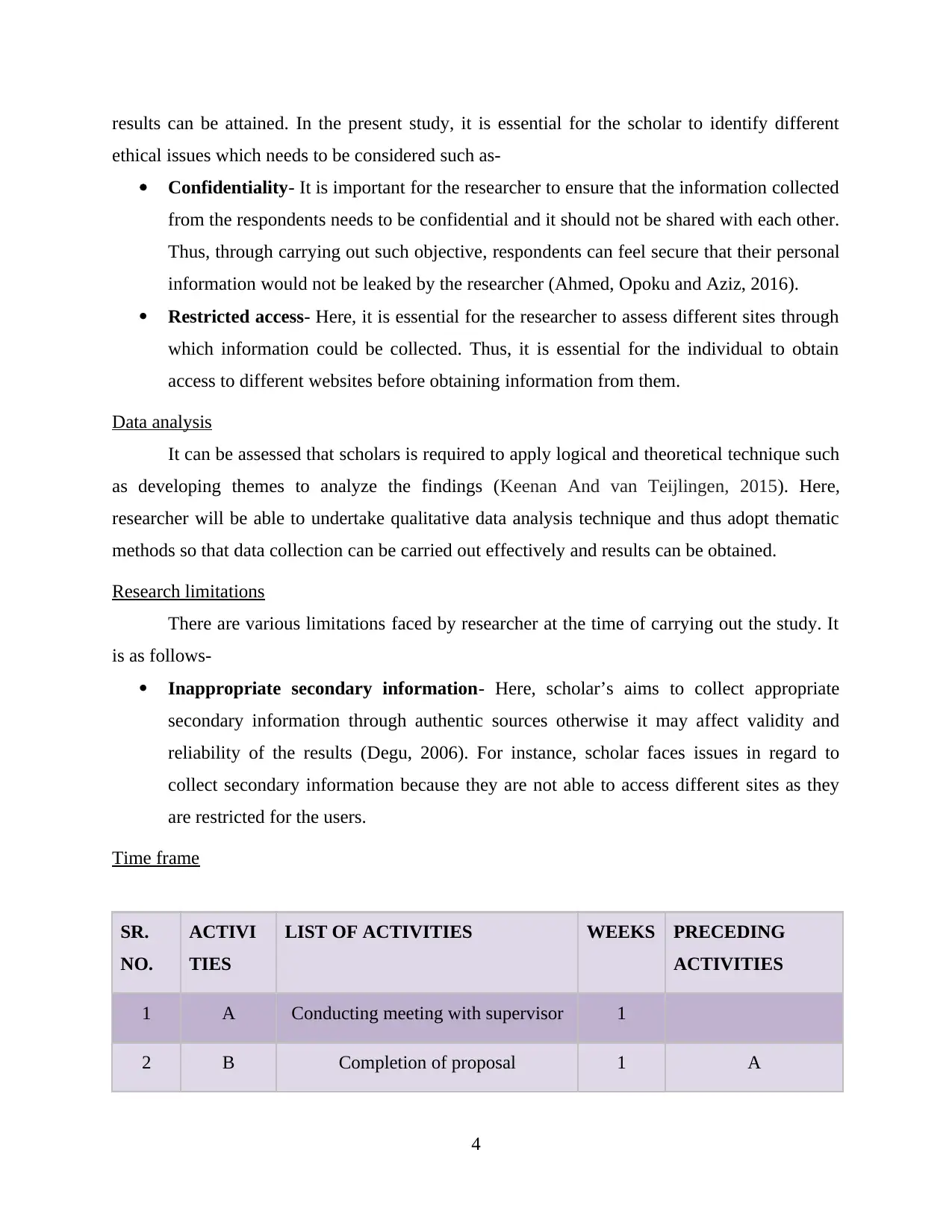
results can be attained. In the present study, it is essential for the scholar to identify different
ethical issues which needs to be considered such as-
Confidentiality- It is important for the researcher to ensure that the information collected
from the respondents needs to be confidential and it should not be shared with each other.
Thus, through carrying out such objective, respondents can feel secure that their personal
information would not be leaked by the researcher (Ahmed, Opoku and Aziz, 2016).
Restricted access- Here, it is essential for the researcher to assess different sites through
which information could be collected. Thus, it is essential for the individual to obtain
access to different websites before obtaining information from them.
Data analysis
It can be assessed that scholars is required to apply logical and theoretical technique such
as developing themes to analyze the findings (Keenan And van Teijlingen, 2015). Here,
researcher will be able to undertake qualitative data analysis technique and thus adopt thematic
methods so that data collection can be carried out effectively and results can be obtained.
Research limitations
There are various limitations faced by researcher at the time of carrying out the study. It
is as follows-
Inappropriate secondary information- Here, scholar’s aims to collect appropriate
secondary information through authentic sources otherwise it may affect validity and
reliability of the results (Degu, 2006). For instance, scholar faces issues in regard to
collect secondary information because they are not able to access different sites as they
are restricted for the users.
Time frame
SR.
NO.
ACTIVI
TIES
LIST OF ACTIVITIES WEEKS PRECEDING
ACTIVITIES
1 A Conducting meeting with supervisor 1
2 B Completion of proposal 1 A
4
ethical issues which needs to be considered such as-
Confidentiality- It is important for the researcher to ensure that the information collected
from the respondents needs to be confidential and it should not be shared with each other.
Thus, through carrying out such objective, respondents can feel secure that their personal
information would not be leaked by the researcher (Ahmed, Opoku and Aziz, 2016).
Restricted access- Here, it is essential for the researcher to assess different sites through
which information could be collected. Thus, it is essential for the individual to obtain
access to different websites before obtaining information from them.
Data analysis
It can be assessed that scholars is required to apply logical and theoretical technique such
as developing themes to analyze the findings (Keenan And van Teijlingen, 2015). Here,
researcher will be able to undertake qualitative data analysis technique and thus adopt thematic
methods so that data collection can be carried out effectively and results can be obtained.
Research limitations
There are various limitations faced by researcher at the time of carrying out the study. It
is as follows-
Inappropriate secondary information- Here, scholar’s aims to collect appropriate
secondary information through authentic sources otherwise it may affect validity and
reliability of the results (Degu, 2006). For instance, scholar faces issues in regard to
collect secondary information because they are not able to access different sites as they
are restricted for the users.
Time frame
SR.
NO.
ACTIVI
TIES
LIST OF ACTIVITIES WEEKS PRECEDING
ACTIVITIES
1 A Conducting meeting with supervisor 1
2 B Completion of proposal 1 A
4
⊘ This is a preview!⊘
Do you want full access?
Subscribe today to unlock all pages.

Trusted by 1+ million students worldwide
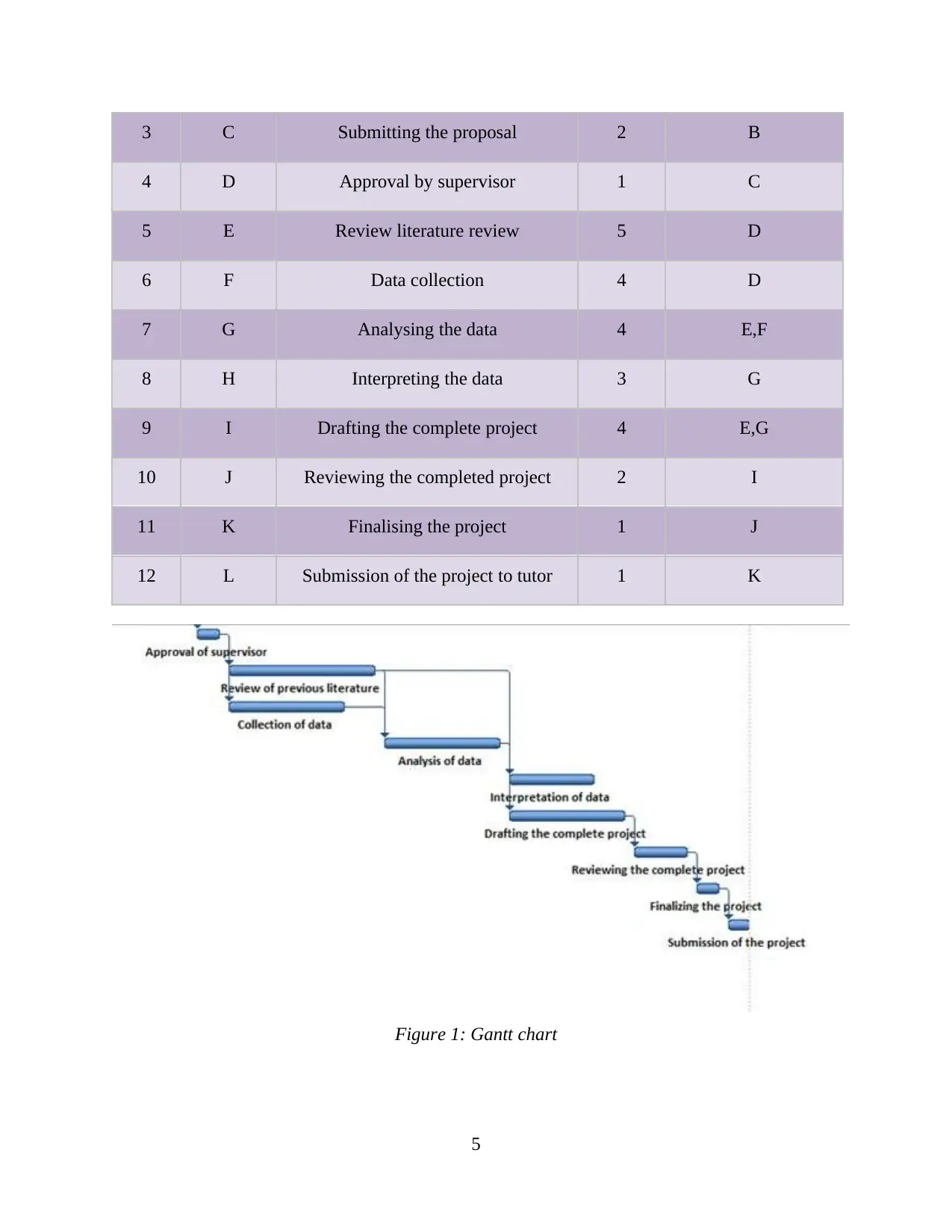
3 C Submitting the proposal 2 B
4 D Approval by supervisor 1 C
5 E Review literature review 5 D
6 F Data collection 4 D
7 G Analysing the data 4 E,F
8 H Interpreting the data 3 G
9 I Drafting the complete project 4 E,G
10 J Reviewing the completed project 2 I
11 K Finalising the project 1 J
12 L Submission of the project to tutor 1 K
Figure 1: Gantt chart
5
4 D Approval by supervisor 1 C
5 E Review literature review 5 D
6 F Data collection 4 D
7 G Analysing the data 4 E,F
8 H Interpreting the data 3 G
9 I Drafting the complete project 4 E,G
10 J Reviewing the completed project 2 I
11 K Finalising the project 1 J
12 L Submission of the project to tutor 1 K
Figure 1: Gantt chart
5
Paraphrase This Document
Need a fresh take? Get an instant paraphrase of this document with our AI Paraphraser
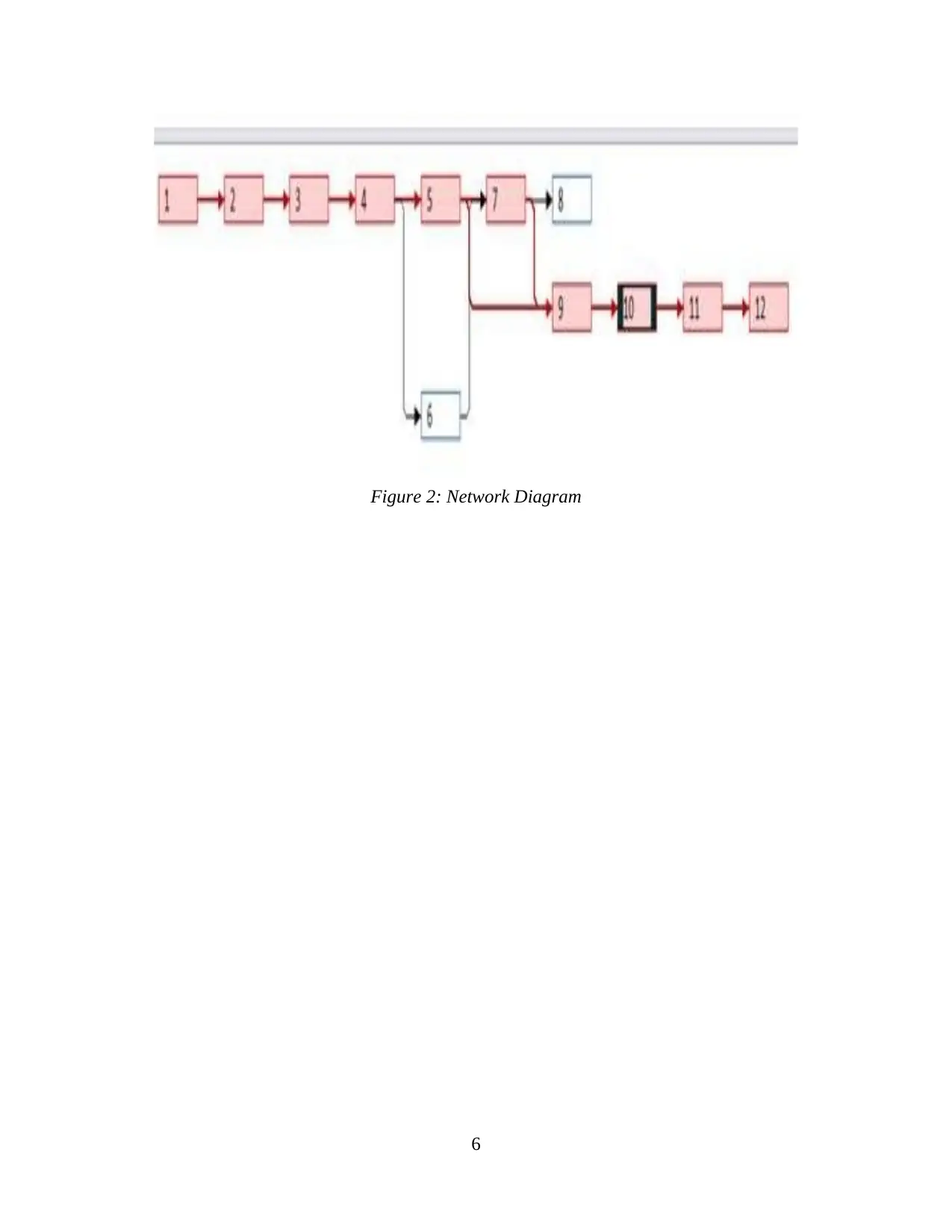
Figure 2: Network Diagram
6
6
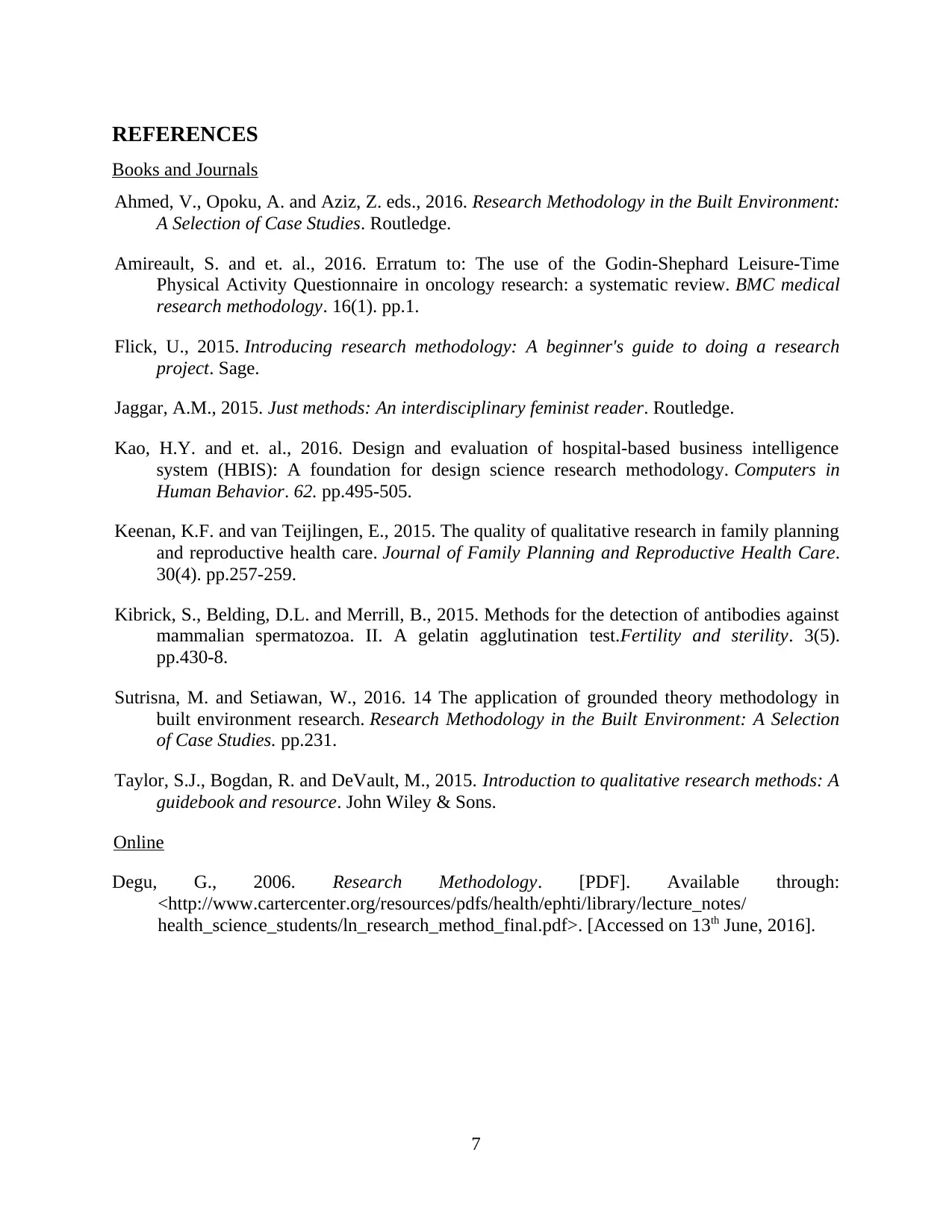
REFERENCES
Books and Journals
Ahmed, V., Opoku, A. and Aziz, Z. eds., 2016. Research Methodology in the Built Environment:
A Selection of Case Studies. Routledge.
Amireault, S. and et. al., 2016. Erratum to: The use of the Godin-Shephard Leisure-Time
Physical Activity Questionnaire in oncology research: a systematic review. BMC medical
research methodology. 16(1). pp.1.
Flick, U., 2015. Introducing research methodology: A beginner's guide to doing a research
project. Sage.
Jaggar, A.M., 2015. Just methods: An interdisciplinary feminist reader. Routledge.
Kao, H.Y. and et. al., 2016. Design and evaluation of hospital-based business intelligence
system (HBIS): A foundation for design science research methodology. Computers in
Human Behavior. 62. pp.495-505.
Keenan, K.F. and van Teijlingen, E., 2015. The quality of qualitative research in family planning
and reproductive health care. Journal of Family Planning and Reproductive Health Care.
30(4). pp.257-259.
Kibrick, S., Belding, D.L. and Merrill, B., 2015. Methods for the detection of antibodies against
mammalian spermatozoa. II. A gelatin agglutination test.Fertility and sterility. 3(5).
pp.430-8.
Sutrisna, M. and Setiawan, W., 2016. 14 The application of grounded theory methodology in
built environment research. Research Methodology in the Built Environment: A Selection
of Case Studies. pp.231.
Taylor, S.J., Bogdan, R. and DeVault, M., 2015. Introduction to qualitative research methods: A
guidebook and resource. John Wiley & Sons.
Online
Degu, G., 2006. Research Methodology. [PDF]. Available through:
<http://www.cartercenter.org/resources/pdfs/health/ephti/library/lecture_notes/
health_science_students/ln_research_method_final.pdf>. [Accessed on 13th June, 2016].
7
Books and Journals
Ahmed, V., Opoku, A. and Aziz, Z. eds., 2016. Research Methodology in the Built Environment:
A Selection of Case Studies. Routledge.
Amireault, S. and et. al., 2016. Erratum to: The use of the Godin-Shephard Leisure-Time
Physical Activity Questionnaire in oncology research: a systematic review. BMC medical
research methodology. 16(1). pp.1.
Flick, U., 2015. Introducing research methodology: A beginner's guide to doing a research
project. Sage.
Jaggar, A.M., 2015. Just methods: An interdisciplinary feminist reader. Routledge.
Kao, H.Y. and et. al., 2016. Design and evaluation of hospital-based business intelligence
system (HBIS): A foundation for design science research methodology. Computers in
Human Behavior. 62. pp.495-505.
Keenan, K.F. and van Teijlingen, E., 2015. The quality of qualitative research in family planning
and reproductive health care. Journal of Family Planning and Reproductive Health Care.
30(4). pp.257-259.
Kibrick, S., Belding, D.L. and Merrill, B., 2015. Methods for the detection of antibodies against
mammalian spermatozoa. II. A gelatin agglutination test.Fertility and sterility. 3(5).
pp.430-8.
Sutrisna, M. and Setiawan, W., 2016. 14 The application of grounded theory methodology in
built environment research. Research Methodology in the Built Environment: A Selection
of Case Studies. pp.231.
Taylor, S.J., Bogdan, R. and DeVault, M., 2015. Introduction to qualitative research methods: A
guidebook and resource. John Wiley & Sons.
Online
Degu, G., 2006. Research Methodology. [PDF]. Available through:
<http://www.cartercenter.org/resources/pdfs/health/ephti/library/lecture_notes/
health_science_students/ln_research_method_final.pdf>. [Accessed on 13th June, 2016].
7
⊘ This is a preview!⊘
Do you want full access?
Subscribe today to unlock all pages.

Trusted by 1+ million students worldwide
1 out of 9
Related Documents
Your All-in-One AI-Powered Toolkit for Academic Success.
+13062052269
info@desklib.com
Available 24*7 on WhatsApp / Email
![[object Object]](/_next/static/media/star-bottom.7253800d.svg)
Unlock your academic potential
Copyright © 2020–2025 A2Z Services. All Rights Reserved. Developed and managed by ZUCOL.





